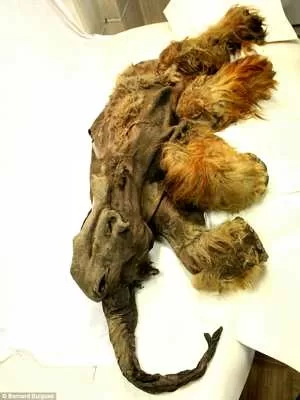Imagine cracking open a prehistoric time capsule and discovering a perfectly preserved baby mammoth – complete with reddish-blonde hair! This isn’t science fiction, but a recent discovery that’s rewriting our understanding of these Ice Age giants.
Yuka: A Frozen Time Capsule from Siberia
Deep within the Siberian permafrost, a hidden treasure emerged – the exquisitely preserved remains of a young woolly mammoth. Affectionately named Yuka, this little mammoth offers a fascinating glimpse into the past. Standing between 9 and 15 feet tall at the time of its demise, Yuka is estimated to be around 10,000 years old and provides a wealth of information for paleontologists.
Beyond the Usual Brown: A Mammoth with Ginger Flair
One of the most striking features of Yuka is its fur. Unlike the typical dark brown fur associated with woolly mammoths, Yuka boasts a unique strawberry-blonde coat. This discovery challenges our long-held assumptions about mammoth coloration and raises questions about the diversity of their fur patterns.
Genetic Clues and the Mystery of Mammoth Fur
Prior to Yuka’s discovery, scientists had only theorized about the possibility of lighter-colored mammoths based on genetic analysis of ancient bones. Yuka now serves as living proof (well, not quite living!), supporting the notion that mammoths weren’t a uniform bunch when it came to fur color. This finding opens exciting possibilities for further research into mammoth genetics and evolution.

A Story of Survival and Potential Human Interaction
Yuka’s story isn’t just about fur color. Examination of the remains revealed a broken leg and various flesh wounds. These injuries suggest a struggle for survival, with some wounds possibly inflicted by another predator. However, other marks on Yuka’s body hint at a more intriguing possibility – human interaction.
Did Humans and Mammoths Cross Paths?
The specific cut marks and openings on Yuka’s body differ from what would be expected from a typical predator attack. This raises the intriguing possibility that humans might have been involved, perhaps “stealing” the carcass from another predator. If confirmed, this would be the first evidence of interaction between humans and mammoths in this specific region.
A Collaboration Between Tusk Hunters and Scientists
The discovery of Yuka is a testament to collaboration. Tusk hunters in Siberia stumbled upon the frozen mammoth and responsibly handed it over to the Mammuthus organization, a group dedicated to mammoth research. This cooperation between local communities and scientific institutions is crucial for furthering our understanding of these prehistoric giants.
Yuka’s Legacy: A Window into the Woolly Mammoth World
The discovery of Yuka is a landmark event in paleontology. This remarkably preserved specimen provides a wealth of information about mammoth biology, behavior, and potentially, their interactions with early humans. Yuka’s story is far from over – as scientists continue their meticulous analysis, we can expect even more fascinating revelations about these Ice Age giants to emerge from the Siberian permafrost.

